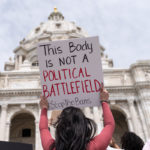
Editor’s Note: This article is part of our project on the importance of storytelling in the fight for abortion access.
Carolyn’s year started on several high notes, kicking off 2023 with a new husband, a new home, a new job in her health care administration career – and a new pregnancy.
It was an exciting time. As of her 10-week checkup, Carolyn’s obstetrician reported a strong heartbeat. She then went in for genetic testing – a standard practice, especially since Carolyn (whose last name is not being used for privacy reasons) is 35 years of age. But she mostly went because she wanted to know the baby’s gender. “We were really excited to know that early,” she says. “We liked the idea of sharing that with people.”
Two weeks later, the results came back – and they held every expecting parent’s worst nightmare. She remembers missing a call from the doctor’s office while she was working, and then immediately receiving a follow-up text. “When I saw that, my heart dropped,” she recalls.
The tests revealed that the fetus had Trisomy 13, a genetic abnormality that impacts development both externally and internally. Often, fetuses with this abnormality do not make it to term – those that do, often do not live to see their first birthdays. “It’s wild how quickly we were going from, ‘How do you want to share the news of the baby? A Disney or sports theme?’ to ‘Are we going out of state [for an abortion]? How does this even work?’”
Indeed, with Texas’ especially harsh abortion ban in place, the Houston resident found that getting medical care would require significant planning. But first, there was a delay – an additional procedure was needed to confirm the diagnosis. Simply put, she needed to be sure. “I was so numb, trying to detach,” she says. “I was also just scared. These are all things I never expected.”
But as it turns out, she and her husband didn’t need to wait much longer – during the procedure, her medical team could observe early signs of complications from the ultrasound alone. “From 10 weeks, when everything looks great, to 13 weeks, when we didn’t even have to wait for the additional test results to come back.”
She adds, “The glimmer of hope we had was gone.”
As devastating as that was, then came the process of getting the abortion itself. Her only option was to go out-of-state, to New Mexico. Gathering information was tough, as Carolyn didn’t even know who to ask, for fear of punishment. “I [was and] am so terrified of getting any provider in trouble, or any friend or neighbor – the whole gamut.”
She and her husband gave themselves a week to plan their trip. They performed covert searches for facilities and hotels. They booked the appointment for a Friday, so she could take off as little time as possible from her new job. They laid out nearly $5,000, between travel and medical expenses.
But, when the day arrived, she was able to get the abortion she needed. Once it was done, “I felt relief – so grateful that we made it to this place, and that everything was taken care of, because there was very little room for error.”
The ordeal wasn’t over yet, however. The couple woke up the next morning to get moving on a spa day they had planned for themselves, when signs of an allergic reaction began to appear. “It felt like I had something in my throat, and really puffy, chapped lips,” she recalls. They attempted over-the-counter remedies, but they didn’t help.
Frantic, they scoured the internet for nearby urgent care facilities, as the abortion clinic itself was closed and they were in an unfamiliar city. Most of them didn’t have appointments until later in the afternoon though, and Carolyn’s condition was rapidly worsening. Still, they held off on going to the hospital, due to both legal and financial concerns. After finally booking a telehealth visit with a nearby provider, she was able to get a prescription for medication.
The order was sent to a local pharmacy – once they figured out where their nearest pharmacy was, that is. But there was more, still, to weather. It took four hours for the prescription to come in, so that the pharmacy tech could fill it. “I remember sitting in an aisle of this CVS – just literally sitting on the floor – and thinking, ‘I give up.’ And my husband’s crying, because he’s so scared. We just needed this medication.”
Carolyn adds, “It was such a chaotic disaster, basically.”
The situation calmed soon after the couple got the medicine – in fact, it worked overnight. The next morning, they headed home, to figure out what would come next. For Carolyn, that meant trying to come to terms with what had happened. “You just feel so alone” when undergoing an abortion while you’re miles away from home. On top of that, “I don’t even think I got the opportunity to process the loss of the baby. It’s been more just – rage.”
That anger galvanized her into action. She got involved with Planned Parenthood’s volunteer program, and regularly attends their informational Zoom sessions. And, she signed on to tell her abortion experience with the public.
She wants people to intimately understand how difficult her experience was. “I was able to make the decision to go out-of-state, and the procedure was seamless. But … this is still awful for those who can [do that]. Because if anything happens, you’re not with your medical team, or friends or family who can help.”
Despite that, Carolyn counts herself among the fortunate. “Even though my experience was traumatic, the fact is: I was able to go out of state. I was able to manage the logistics, the travel, the abortion,” she says. “There’s people in this world that do not have the opportunity to do that. They’re being denied basic health care rights.”



